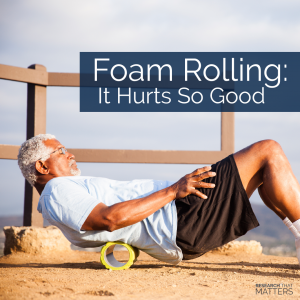Bottom Line
Foam rolling has exploded in popularity over the past few years. No longer used only by athletes and trainers, foam rolling (or myofascial release) is now used by people at all levels of fitness. The goal of foam rolling is to improve muscle function, performance, and range of motion. When a tight muscle or trigger point is released, you’re better able to move freely, move with less pain, and improve your overall performance.

Why it Matters
Activity, age, and injuries can all cause your muscles to lose flexibility over time, which in turn creates adhesions and pain. Foam rolling allows you to place deep compression on these areas, reducing pain and adhesions while creating improved range of motion. Researchers have discovered that foam rolling during your warm-up can improve flexibility more than static and dynamic stretching.
– Foam rolling is designed to release tight muscles and trigger points.
– Researchers are seeing increased flexibility and reduced pain in study participants after foam rolling.
– Proper movement patterns are thought to improve performance and reduce injury.
Next Steps
Using a foam roller on tight muscles and trigger points has been shown improve flexibility and help maintain proper movement patterns. If you have questions on whether foam rolling is right for you, just ask! We believe this type of at-home care is a great way to support the adjustments you receive in our office. If you know someone who would benefit from this information, share it with them today. When you’re ready, give us a call at 705-722-3131 or use our “contact us” form.
Dr. Michael Miller, DC, DOMP Chiropractor & Manual Osteopath Complete Care Chiropractic
Science Source
Acute Effects of Foam Rolling, Static Stretching, and Dynamic Stretching During Warm-ups on Muscular Flexibility and Strength in Young Adults. Journal of Sports Rehabilitation 2017
Differences in pressure pain threshold among men and women after foam rolling. Journal of Bodywork and Movement Therapies 2017
